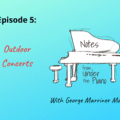Feb 6, 2021
Tricia Tunstall’s Dissertation on The Discovery Orchestra

Tricia Tunstall, former Orchestra trustee and current ambassador, wrote her doctoral dissertation on The Discovery Orchestra!
Tricia is a leading advocate for the importance of music and arts education, and a global force in promoting the El Sistema movement (the mission of El Sistema is to effect social change through music for children with the fewest resources and the greatest need).
Learn more about Tricia.
It is our pleasure to post a chapter of Tricia’s dissertation on our website. What follows is a bit of the intro, and you can read the entire chapter here.
Introduction: Discovering Stars and Stripes Forever
It’s a Sunday afternoon in November 2008. The small but state-of-the-art concert hall at SOPAC, the South Orange Performing Arts Center in South Orange, New Jersey, is nearly full; the audience includes a wide variety of ages and concert attire choices. Elderly men in checked sports jackets and ladies with brooches on their sweaters mingle with casually dressed forty-somethings and their even more casually dressed children. A few minutes after 3 PM, the house lights dim as members of The Discovery Orchestra walk onstage and take their seats. As the instruments tune, it becomes apparent that the ensemble onstage today is not the full Discovery Orchestra but a concert band version of it, with no stringed instruments. This is not a surprise for the audience members who’ve already glanced at the program: it is entitled Discover Sousa.
The audience applauds as conductor George Marriner Maull enters, heading for the podium at a fast clip. He lifts his baton; the orchestra launches into John Phillip Sousa’s Stars and Stripes Forever. Their rendition of the three-and-a-half minute march is both polished and rousing, and a nodding head or tapping hand can be seen here and there in the audience.
Maestro Maull takes a deep bow and asks his ensemble to stand. “He looks like a conductor, doesn’t he?” whispers an audience member to her companion. And he does have an old-fashioned, grand-style conductorial presence, with a shock of glossy black hair down to the collar of his tuxedo shirt, a mustache, and a trim beard. His deep voice is amplified by a lavaliere microphone. “Good afternoon, ladies and gentlemen,” he says. “That was of course Stars and Stripes Forever, by John Phillip Sousa. How many of you have heard it before?” All hands go up. “It’s wonderful, isn’t it?!” he continues. “Now here’s another question: how many of you have listened to it?”
After a moment, some hands go halfway up. The maestro gestures to his musicians to sit down and then addresses the audience. “You know,” he says, “we all frequently hear music that we’re not listening to. We can’t help it. That’s our common experience of music these days. No matter where we go – to the mall or the ice cream store or the doctor – it’s literally coming out of the walls, out of the ceiling. So when you go to a concert, sometimes it’s hard to know exactly how to listen to the music in a way that gives you real emotional satisfaction.
“That’s our mission today. We’re going to learn how to really listen to Stars and Stripes Forever.”
He tells the audience to look at their Listening Guides, black-and-white brochures tucked inside their programs. “As you see, the first thing that happens is the Introduction – a grandiose musical gesture that kind of makes people sit up and take notice. I’m going to have the orchestra play just the intro for you. And I want you to listen closely and tell me how many measures it has.”
The Listening Guide is a simple program-sized document, full of scraps of musical notation mingled with written words, graphic gestures, and pictures of instruments. The first page is structured in three blocks. In the uppermost block is written the composer’s full name and dates of birth and death, and then the full name of the piece, The Stars and Stripes Forever March; beneath that is a note saying that it was composed on Christmas Day in 1896.
Next comes a line in bold print, as follows:
FORM: Intro-AA-BB-Trio-Bridge- Trio-Bridge-Trio.
And under that, in even bigger bold print:
1. INTRODUCTION, OF MEASURES. ff
All this comprises the first block of the Listening Guide.
As the audience members peruse their guides, the orchestra blasts through the introduction and stops abruptly. “Do you see the blank in that first sentence – introduction of blank measures? asks Maull. “How many measures did you detect?” A short silence, then a few people call out from various spots in the audience. “Four?”
Tags:









